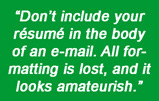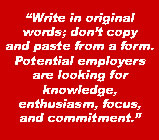 |
 |
 |
|
|
Shelley's Guide to
Technical Theatre Résumés: Part Three The first two installments of this essay examined rules and layout structures for résumés. This installment will analyze the presentation and delivery of a technical theatre résumé. E-mail Rules: • Don't include your résumé in the body of an e-mail. All formatting is lost, and it looks amateurish. • When attaching a résumé to an e-mail, convert it to a PDF file. That way it can't easily be changed. As important, the "look" of the special font, which may be unique to the candidate's hard drive, will be included. • Title the document with your name, not just "resume. PDF." On the average, I receive five e-mailed résumés a week. When they are all titled "resume. PDF," I then have to open them, read each name, and re-title. • Get an e-mail address that looks and sounds professional like your name, not something like FluffyBunny@cutsiepooh.org. Cover Letter: • Address the letter to the person who is doing the hiring. If the name is unknown, do the research. It is much better than "To Whom It May Concern." Check their title (Mr., Ms., Mrs., etc.) and the spelling of their name. • Write in original words; don't copy and paste from a form. Potential employers are looking for knowledge, enthusiasm, focus, and commitment. • Check the spelling for the hiring organization. Research the organization to make a statement that shows the letter is not just a response to an ad. • The cover letter should be one page of three or four brief paragraphs: • First Paragraph: Answer the reader's question, "Why am I reading this?" Note any connection such as, "Patrick suggested that I contact you regarding…" Note the job applied for. • Second and Third Paragraphs: Describe strengths and skills and how they apply to the position sought. Highlight a relevant job or an experience that tested these abilities and describe how the challenge was met. • Rather than "I will wait for your call," indicate that a call or e-mail will follow to check on the status of the application. Arrange a meeting if that's appropriate. Observations: Sometimes it seems like résumé writing and updating never ends. Update one, create a new one, and so on. Résumé-writing in itself is a skill that is developed and refined over an entire career. Remember, too, that the résumé is not only a representational tool; it can often be used as a conversation starter. When it's appropriate, talk to potential employers and ask them to critique the résumé. This tactic may reveal other methods and opinions about résumés that may be more suited to you. In addition, speaking to potential employers in this more relaxed atmosphere may be just as beneficial as a formal interview. At the beginning of a career, there's never enough text to fill the page. There will always be the temptation to include everything possible in order to visually fill the space on the page. Don't give in to this inclination. Just present the information in a clear, concise layout. The fact that the résumé isn't filled with unnecessary bulk may help it stand out from the rest of the crowd. Finally, though it's frustrating to constantly rewrite a résumé while looking for jobs, keep in mind that no one is irreplaceable. We all have to rewrite our résumés and keep them current because, eventually, we all need them again. Steven L. Shelley has designed lights, managed productions, and toured for over 35 years. In the last year, he has worked for Patti LuPone, Paul Winter, and the Spoleto Festival USA. He is the designer of the plastic Field Templates and the VectorWorks toolkit SoftSymbols, available at www.fieldtemplate.com. He is author of A Practical Guide to Stage Lighting. He can be reached by e-mail at shelley @fieldtemplate.com. |
   |